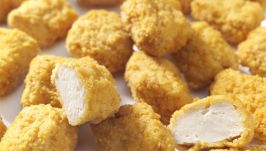Evaluation of Unicell fibre in bread
Tags: bakery
Bread without fiber (formula)
| No. | Ingredient | Quantity in grams | Quality loaf |
|---|---|---|---|
| 1 | Wheat flour, type 550 | 64.70 | 500.00 |
| 2 | Water | 38.80 | 300.00 |
| 3 | Skimmed milk powder | 2.10 | 16.00 |
| 4 | Oil | 1.94 | 15.00 |
| 5 | Sugar | 1.94 | 15.00 |
| 6 | Salt | 0.91 | 7.00 |
| 7 | Dry yeast | 0.65 | 5.00 |
| 8 | Total | 111.04 | 858.00 |
| Finished product | 100.00 | 773.00 |
Bread with Unicell fiber 90 (formula)
| Wheat flour, type 550 | Ingredient | Quantity in grams | Quality loaf |
|---|---|---|---|
| 1 | Wheat flour, type 550 | 62.10 | 485.00 |
| 2 | Water | 42.25 | 330.00 |
| 3 | Skimmed milk powder | 2.05 | 16.00 |
| 4 | Unicell Fiber 90 | 1.92 | 15.00 |
| 5 | Oil | 1.92 | 15.00 |
| 6 | Sugar | 1.92 | 15.00 |
| 7 | Salt | 0.90 | 7.00 |
| 8 | Dry yeast | 0.64 | 5.00 |
| Total | 113.70 | 888.00 | |
| Finished produc | 100.00 | 781.00 |
3,4% - quantity of Unicell fiber 90 per 100 grams of finished product
Bread with Unicell fiber 200 (formula)
| Wheat flour, type 550 | Ingredient | Quantity in grams | Quality loaf |
|---|---|---|---|
| 1 | Wheat flour, type 550 | 62.10 | 485.00 |
| 2 | Water | 42.25 | 330.00 |
| 3 | Skimmed milk powder | 2.05 | 16.00 |
| 4 | Unicell Fiber 200 | 1.92 | 15.00 |
| 5 | Oil | 1.92 | 15.00 |
| 6 | Sugar | 1.92 | 15.00 |
| 7 | Salt | 0.90 | 7.00 |
| 8 | Dry yeast | 0.64 | 5.00 |
| Total | 113.70 | 888.00 | |
| Finished produc | 100.00 | 781.00 |
3,3% - quantity of Unicell fiber 200 per 100 grams of finished product
Comparison of bread: without fiber, with Unicell fiber 90, with Unicell fiber 200
| Proposal | Bread without fiber | Bread with Unicell 90 | Bread with Unicell 200 |
|---|---|---|---|
| Size | Low | High | Medium |
| Colour | Creamy | Creamy | Slightly gray |
| Structure | Condensed with small, round, evenly distributed air pockets | Aerated, with larger, oval air pockets, more on top | Aerated with the biggest air pockets, more on top, with jagged shape |
| Moisture on second day | 41,56% | 42,30% | 43,11% |
| Taste | No differences compared to CT | No differences compared to CT | |
| Weight | 773 g | 2,5% more | 3,0% more |
| Bread crumbling when sliced | No differences compared to CT | More then CT | |
| Hardness | No differences compared to CT | No differences compared to CT | |
| Energy | 257 g | 256 g | 251 g |
| 100 g of finished product | 1,66 g | 3,40 g | 3,30 g |
| Possible declaration | No | Yes | Yes |
All tests were performed two days after baking. Bread was stored in the plastic foil.
Aboved tests were conducted in laboratory conditions and for an extensive undertaking may be treated as guidelines only. For industrial requirements, individual parameters of production have to be approved.
Tip: you have to draw attention to the amount of water and choose the parameter individually according to your own recipes and raw materials. Too mch water added results in higher weight but significantly degrade shape and provoke gummy consistency.
Benefits of using Unicell fibers:
- Increased Volume of Dough & Finished Bread
- Maintains Softness for Longer Time
- Improved nutritional profile (If minimum 3% Fibre added)
- Appropriate mesh size
- High Tensile strength
- Better Yield.
How to use:
- Quantity : 2% of Dry Flour Weight
- Apply : Add in Dry Flour (remove the same quantity of flour as Fibre added) & Mix thoroughly + Add Water as per Dough Elasticity (2-3 time of Fibre Weight)
Conclusions of using Unicell fibers:
- Both mesh - WF90 and WF200 improve shape and weight of the finished product
- Adding UNICELL WF90 results in better sensory parameters (taste, color, aeration) than products with UNICELL WF200 added or CT
Nutrition information per 100 g of finished product (in accordance with EU Regulation No. 1169/2011)
| Nutrient | Bread without fiber | Bread with Unicell 90 | Bread with Unicell 200 |
|---|---|---|---|
| Energy | 1100kJ/260 kca | 1096kJ/259 kcal | 1075kJ/254 kcal |
| Fat (of which saturated fatty acids) | 3.00 g (0,4 g) | 3.00 g (0.4 g) | 3.00 g (0.4 g) |
| Carbohydrates (of which sugars) | 49.00 g (4,3 g) | 48.00 g (4.3 g) | 47.10 g (4.20 g) |
| Fiber | 1.60 g | 3.40 g | 3.30 g |
| Proteins | 8.40 g | 8.30 g | 8.10 g |
| Salt | 0.91 g | 0.94 g | 0.91 g |
Salt = sodium x 2,5



